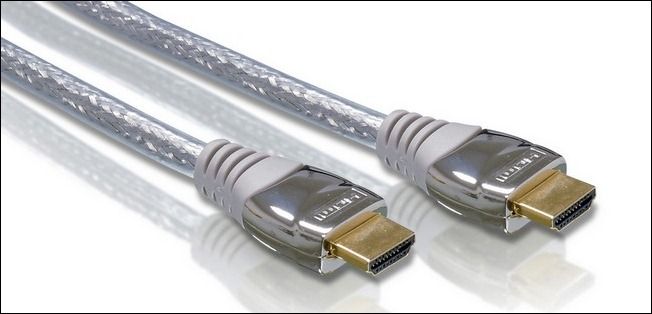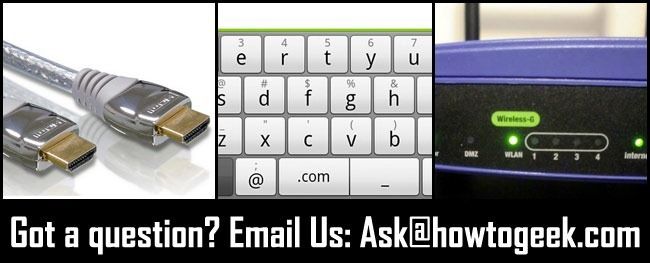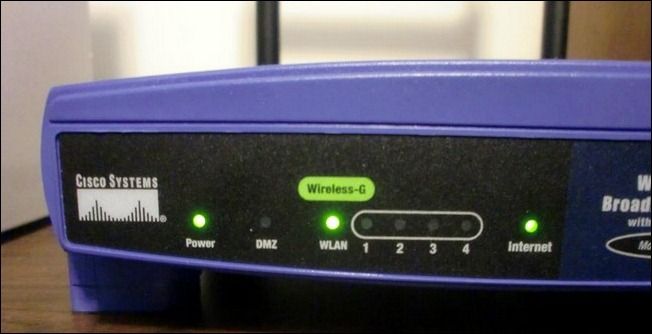Quick Links
Each week we dip into our reader mailbag and answer your pressing tech questions. This week we're looking at an HDMI connection with phantom sound issues, how to install the stock Android keyboard, and how to log URLS visited from your network.
Fixing Phantom HDMI Sound Problems
Dear How-To Geek, I'm hoping you can help solve a very weird tech issue I'm having. I feel like there is a ghost living in my media center. When my wife uses the media center there is never any sound until she reboots the system---every time she goes to watch a movie or TV show the sound is always missing. Whenever I use the system the sound works just fine. I cannot figure it out. I've looked at all the settings, I've updated drivers, I just cannot figure it out. The system is a hand built PC with a micro ATX board that has a built in HDMI port, running XBMC, connected to an HDTV by an HDMI cable from the motherboard. I've done everything I can think of including swapping the HDMI cable. What gives? It's driving me crazy! Sincerely, HDMI Tripping in Houston
Dear HDMI Tripping, You'll laugh (or cry) when you hear what the issue is with your setup. We're not the gambling sort but if we were, we'd bet a large sum of money on this scenario: when your wife goes to use the media center she turns on the media center first then the HDTV and when you use the media center you turn the HDTV on first then the media center. We've seen the issue with enough different HDMI devices (especially motherboards with HDMI ports) that we'd almost guarantee that's the issue. Some device/televisions combinations have a very odd quirk with HDMI cables/ports in that the sound and/or video (but almost always just the sound) fails to initialize when the device is turned on before the television. Since it seems to effect primarily HTPCs our theory is that the hardware switches to other audio devices when there is no signal response on the HDMI port for sound. Perhaps updating your BIOS on the HTPC might help? In short, turn the HDTV on first, then the media center, and your haunting problems will vanish.
Changing the HTC Keyboard to the Default Android Keyboard
Dear How-To Geek Last week you shared a sweet tip about swiping up to expand the Android keyboard. I tried it on my Sprint HTC Evo and nothing happened. According to the phone it's running 2.3.3 which is higher than the 2.2 you said it required. What gives? Am I doing something wrong? Sincerely, Keyboard Longing in Connecticut
Dear Keyboard, You're not doing anything wrong. The HTC Evo ships with the HTC custom keyboard (not the default Android keyboard the trick applies to). What you need to do is install the default keyboard so you can enjoy the swipe-up-to-extend trick. You can visit this XDA Developers thread to grab a copy of the keyboard and install it on your phone. Once installed you'll just need to set it as the default the first time it prompts you. If you end up disliking the new keyboard, check out our guide to switching the default application for Android tasks to re-enable the HTC keyboard.
Log Every URL Visited On Your Network
Dear How-To Geek, Hi there, I am running DD-WRT firmware on my router and have syslog enabled. I would like to know if it is possible to monitor URLs that are visited on my network? If so what tools are out there for Windows and what would be the simplest one? Sincerely, Minding My Traffic in Texas
Dear Minding, To the best of our knowledge there is no plugin or snippet of code for a DD-WRT enabled router that would accomplish what you're looking for. The problem is the leap from logging IP addresses to logging URLs... essentially your router would have to scan each IP request for an HTTP header and then resolve the URL. It's not that intensive of a process (your web browser does it just fine after all) but it's a bit much to ask of the lightweight processors you find in routers. Exporting the log into Windows and resolving all the URLs there is a possibility but it's pain, wouldn't be real time, and things that are a pain and not in real time are rarely maintained. That said you should check WallWatcher, a Window-based application that pulls the logs off routers and analyzes them (including IP-to-URL resolution) if you really want to work with the log files on your computer. To avoid having to pull your own logs and toss them in an application you might want to check out OpenDNS as an alternative solution. OpenDNS has built in tools that allow you to check all the URLs visited from any device behind your router. OpenDNS also has the advantage of not cluttering up your router with log files or requiring you to transfer and resolve them. Also, you can login to your OpenDNS account from anywhere in the world and check the URLs, handy if you want to keep an eye on the sites your kids are visiting while you're on a business trip or some such thing. You can check out how to configure DD-WRT for OpenDNS here. The only downside to using OpenDNS is that unlike logging at the router level you won't be able to see which specific device is accessing which URL. In such a case it would be worth keeping the syslog active and if the need arose you could reverse lookup the URL in question and scan the syslog to see which device is visiting it (or dump the logs into the previously mentioned WallWatcher).
Have a pressing tech question? Shoot us an email at tips@howtogeek.com and we'll do our best to get to the bottom of your problem.


